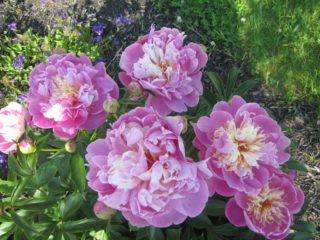Content
Blue peonies are still an unrealistic dream of enthusiastic gardeners. Breeders are working on a problem, but they managed to get only varieties with lilac petals of cold shades. Therefore, amateurs should soberly evaluate the offers of gardening online stores.
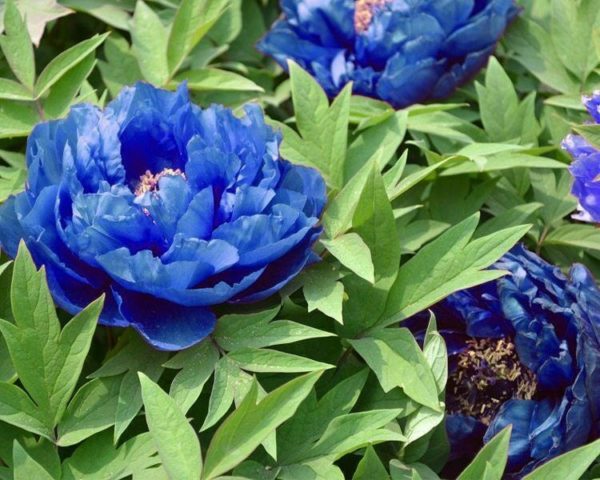
Blue peonies are often just a wonderful result of Photoshop
Are there blue peonies
Peonies are distinguished by a variety of colors - from snow-white to dark red and deep burgundy. The only color that is not in the palette of this culture is blue or light blue. Although recently, offers to buy exotic peonies of the color of a cloudless sky are often found in online stores. Unfortunately, in reality now it is almost impossible to acquire a variety of such a shade. Genetically, the peony is not disposed to form flowers with blue petals. The lack of a blue gene in this culture prevents scientists from reaching a solution to the current problem. As a result of selection, only different shades of lilac-pink or maroon colors were always obtained, which does not correspond to the definition of "blue" in Russian.
Varieties of peonies with flowers of blue and blue shades
Most of the new varieties with various shades of purple are of the tree peony species. Almost all bushes are winter-hardy, covered with lush greenery, which boasts a special decorative effect and decorates the garden throughout the warm season. Many varieties with lilac-burgundy petals can grow in semi-shaded areas.
Blue sapphire
On powerful tree-like shoots of the Blue Sapphire variety, up to 1.2 m high, inflorescences with a diameter of 16-17 cm with light pink petals open. Strong flower stalks bear large crowns, the petals of which at the base are painted with stripes of a dark purple hue and crimson-burgundy blotches. The flowers are delicate watercolor, very attractive.
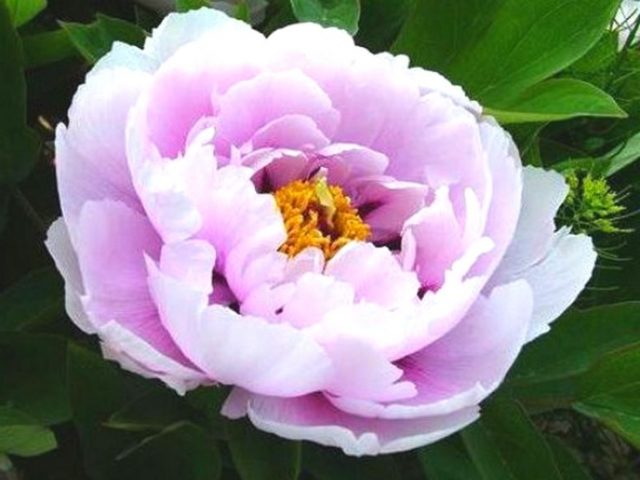
Blue sapphire pleases with flowering 10-15 days
Blue bird
Plants are tall, up to 1.5 m and more. On strong branched shoots of an adult bush, many double flower caps of a cold pink-lilac tone are formed. During flowering, which lasts up to 2 weeks, the shoots under the lush flowers tend to the ground.
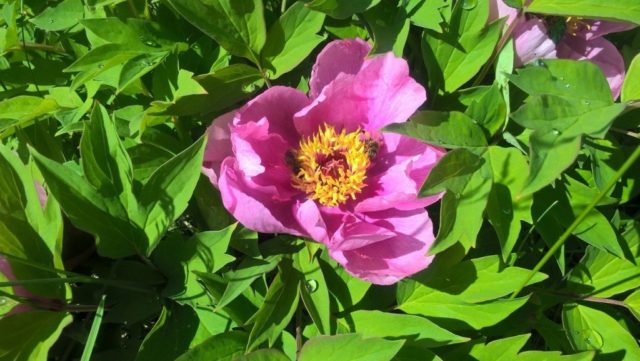
The bush of the Blue Bird variety is distinguished by powerful growth
Blue chrysanthemum
A variety of a dwarf ruler, growing up to 50-60 cm, with a flower crown with a diameter of 16-17 cm, is placed in a spacious place, away from trees and large bushes. It blooms at the end of June, spreading an amazing aroma and drawing attention to itself with shiny pink petals with soft tints of purple tones.
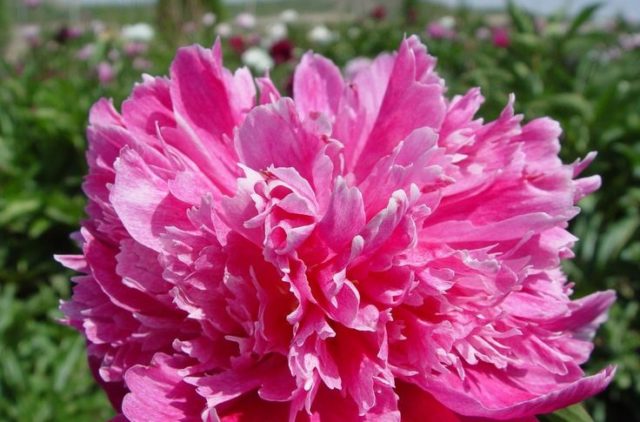
Blue chrysanthemum - undersized bush
Blue balloon
The tree-like variety is known for tall bushes with spreading branches and fluffy flower caps of a cold lilac shade with a bluish tint. The crowns are large, 15-17 cm long. Flowering is long. Shoots rise over 1.5 m. The variety is winter-hardy and undemanding to care.
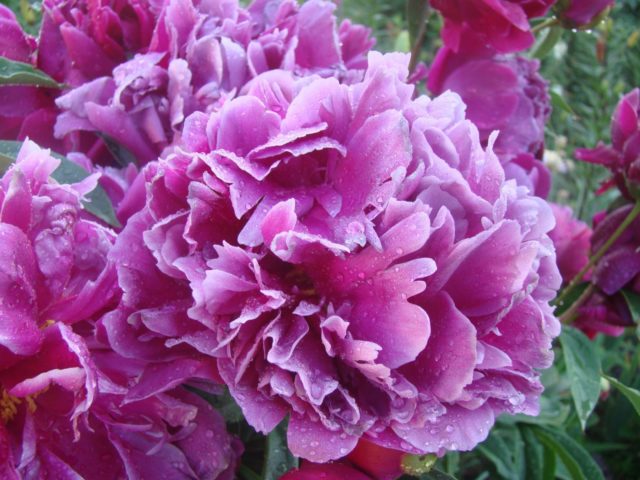
The blue ball pleases with abundant flowering
Blue lotus
The bush of the Chinese tree variety is winter-hardy, vigorous branches rise to 1.2-1.6 m. Leaf blades are rich green.During the flowering period, the bush is covered with intense pink inflorescences, in the petals of which, when playing with light, bluish shades are caught. Prefers to grow in an open, lighted area.

Blue lotus flowers, with good nutrition, reach more than 20 cm in diameter
Blue doe
The vigorous variety Blue Doe rises up to 2 m. A magnificent crown with a diameter of 15 cm is formed by upright lilac petals with bluish nuances under a certain play of light.
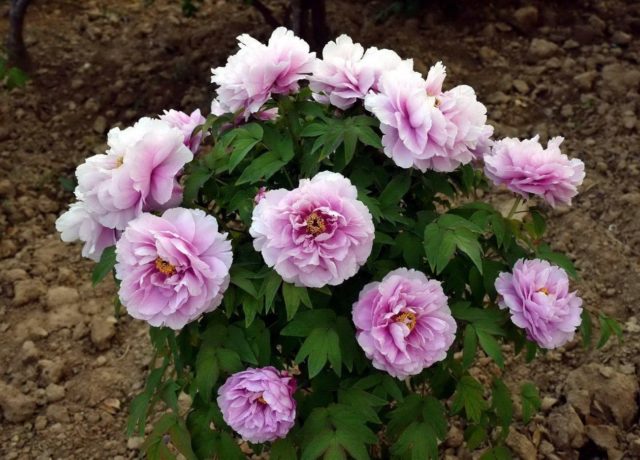
On strong shoots, abundant flowering begins in mid-June
Heavenly Brocade
The bushes are low, 70-80 cm. In June, they are covered with lush crowns, consisting of glossy mauve petals. Flowers sometimes turn into a bluish tint under special, indirect illumination of oblique sunlight.

Heavenly brocade - a representative of the herbaceous species
Song of rain
The tree-like peony has luxurious, densely double flowers with a diameter of 17-19 cm. The bush is vigorous, powerful, 1.7-1.9 m high. It blooms luxuriantly, but for a relatively short time, up to 7-10 days. The petals are light purple, delicate lavender in color, along the edge with a delicate bluish tint.
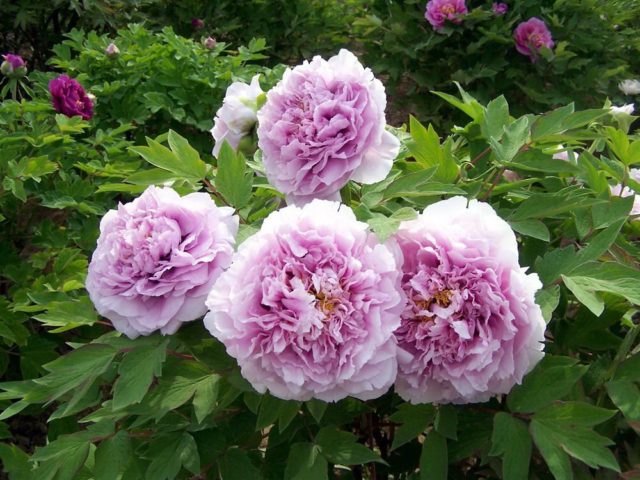
The variety Song of Rain is decorative and its oblong leaves with burgundy veins
The deep blue sea
The winter-hardy tree-like peony grows up to 1.3-1.6 m. At the tops of strong shoots, amazing caps of dark crimson petals sway, which at times surprise with the overflow of lilac-blue tones. The plant prefers drained alkaline soil rich in nutrients.
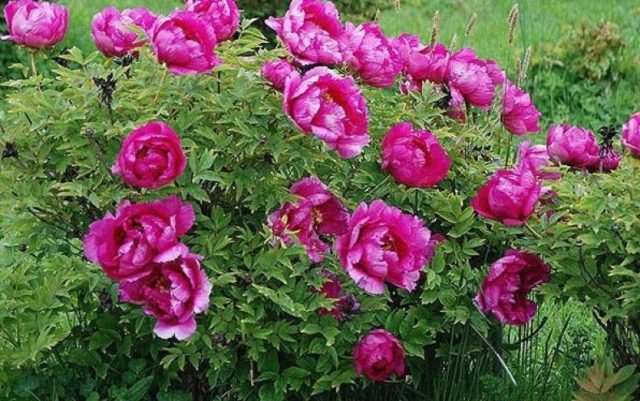
The variety amazes with the intensity of the color of the flowers.
Blue and blue peonies in landscape design
Plants with bluish hues will brighten any garden and give a delightful scent. Since for the most part these are powerful, spreading specimens, they are not planted near other plants. The distance between the bushes is at least 1.5 m. Also, ground covers are not placed under the peonies. The site is thickened only with early spring bulbs, which precede the flowering of the main crop.
There are many design solutions:
- creation of magnificent curtains in spacious meadows;
- tapeworms in flower beds;
- tall tree peonies are placed as a backdrop for lower flowers;
- undersized varieties are used in border elements;
- profusely flowering bushes and carved leaves look beautiful in rock gardens and rockeries.
Strong-growing tree peonies are especially decorative. Contrasting or harmonious in color plants act as partners for species with blue shades of lilac-pink petals:
- daylilies cream and yellow;
- blue sage;
- various irises;
- bright poppies;
- white, blue and purple bells.
Planting and caring for blue peonies
The culture is unpretentious to growing conditions, prefers brightly lit areas, but tolerates partial shade and even needs it in the southern regions. The land should be well-drained, fertile, preferably light loam. When planting, humus, 300 ml of wood ash, 100 g of potassium sulfate and superphosphate are placed in the pit. Acidic soils are limed at the rate of 1 kg of lime or dolomite flour per 10 liters of water. Planting is carried out only at the end of August, in September.
A peony grows in one place for a very long time. The bush requires abundant, but rare watering. For one adult specimen, from 2 to 5 buckets of water are consumed, watering the plant at the root. In the spring, fertilize with nitrogen preparations or organic matter. At the beginning of the creation of the buds, they are supported with phosphorus preparations. The third time, at the beginning of the blooming of flowers, feeding is carried out with the same composition. Watering does not stop until autumn and always keep the soil in a loose state.
Pests and diseases
Tree peonies are resistant to various fungal diseases. If a focus of infection is found on plants near the bush, it is necessary to carry out prophylaxis with any fungicide. Viral diseases cannot be cured, so plants with mosaic lesions are removed from the site.
Peonies are most affected by the neighboring colonies of aphids and ants. To remove ants from the site, either transfer their nests to the wild, or use highly targeted preparations. Aphids are destroyed with folk remedies, spraying plants with solutions of soda or soap.
In the phase of pouring the buds, peonies must be checked every morning for the presence of bronzes. Beetles suck the juice from the buds and thus disfigure the flower, which has underdeveloped and crippled petals.
If the bush withers, the rhizomes are checked for infection with rootworm nematodes. In the case of a confirmed diagnosis, the plant is dug up and taken to a centralized waste collection point or burned.
Conclusion
Blue peonies with ultramarine petals are a beautiful fairy tale for gullible gardeners. But lavender varieties have their own special charm. The plant will decorate the garden and give it a unique charm.






